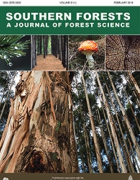Balancing forest regeneration and meeting food and fibre needs of Nigerias ever-increasing population challenges is imperative to her sustainable development. Two methods of artificial forest regeneration practiced in Oyo State, Nigeria to meet these challenges are direct planting and taungya systems. This paper reports the performance of the taungya system of forest regeneration in Osho Forest Reserve, Oyo State, Nigeria with a view to harnessing information for informed and effective policy decision on sustainable forestry development. Four out of seven taungya centres within and around the reserve were purposively studied using questionnaire administration, oral interviews and direct field measurement. Direct field measurement was undertaken in 10 temporary sampling
plots, each measuring 25 m × 25 m. The data collected were analysed using descriptive and inferential statistics at P = 0.05. The taungya farmers in the study area were male and a majority (76.0%) had no formal education. More than half of the farmers (56.0%) had knowledge about taungya and silvicultural operations, while 82.0% of them had no other farm outside the taungya farm. The observed survival of trees planted on the farms was high. Significant variation was observed in the circumference at breast height (Cbh) of species under the direct planting and taungya systems with Gmelina arborea contributing to most of the variation and the differences in stand age. The survival percentage of tree species under taungya was higher (52.0% ha

